五分钟打造自己的sql性能分析工具
1.首先要有一个trace文件
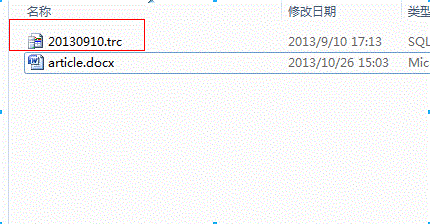
2. 打开trace文件

3. 另存为跟踪表
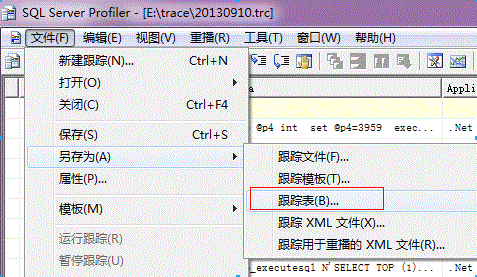
4.登录你要保存到的目标sqlserver服务器

5. 选择要保存的数据库和表名称

6. 保存完成(左下角出现进度直到显示“已完成”)
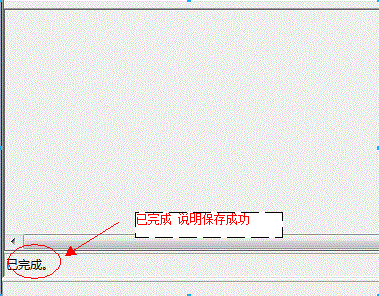
7. 在数据库中找到该表(在第5步选择的数据库中找)

8.查看部分结果(TextData就是查询的sql语句,Duration就是查询的时间,这里duration除以1000才是毫秒)

9. 然后我们来分析TextData,如何找到相同的语句,不同的参数。我的分析,TextData主要有3种
1)带参数sql语句(以 exec sp_executesql N' 打头,以 ',N' 结尾可以找出对应的sql语句),如下图
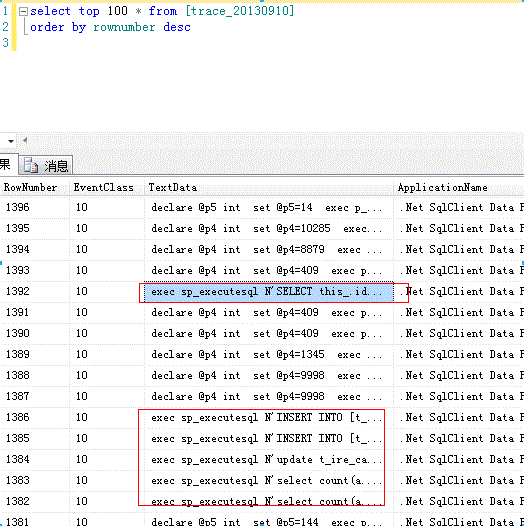
2)存储过程(类似 exec porc_user_insert @username, exec 和 @ 之间为存储过程名),如下图
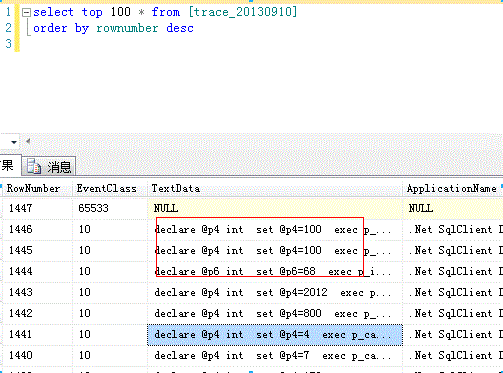
3)不带参数的sql语句
10. 对trace表的数据进行处理前的一些准备:
1)update trace_20130910 set duration = duration / 1000 where duration is not null -- 时间改为毫秒
2)修改 textdata 为 nvarchar(max)类型,因为textdata默认保存为ntext类型,处理不方便
alter table trace_20130910 alter column textdata nvarchar(max)
3)新增两个字段
alter table [trace_20130910] add proc_sql nvarchar(max) -- 保存该textdata调用的存储过程,原始sql等;
alter table [trace_20130910] add proc_sql_id int -- 为存储过程和原始sql指定一个编号
11. 处理trace数据
1)找出执行的sql脚本(带参数) ,更新到 proc_sql 字段
update [trace_20130910]
set proc_sql = replace(left(textdata,charindex(''',N''',textdata) - 1),'exec sp_executesql N''','')
where (proc_sql is null or proc_sql = '' )
and charindex('exec sp_executesql N', textdata ) = 1
2)找出执行的存储过程,更新到 proc_sql 字段
update [trace_20130910]
set proc_sql =
replace(
replace(
left(
right(textdata,len(textdata) - charindex('exec ',textdata) + 3),
charindex('@',
right(textdata,len(textdata) - charindex('exec ',textdata) + 3)
)
),'exec ','')
,'@','')
where (proc_sql is null or proc_sql = '' )
and charindex('exec ',textdata) > 0
3)找出没有参数的sql脚本,更新到 proc_sql 字段
update [trace_20130910] set proc_sql = textdata where proc_sql is null and textdata is not null
12. 统计
1)新建表,用于保存统计数据,trace_20130910每个proc_sql对应一行
create table [trace_20130910_stat]
(
id int identity(1,1) primary key,
databaseid int,
proc_sql nvarchar(max), -- 对应trace_20130910的proc_sql
total_duration bigint, -- 总耗时
max_duration int, -- 该语句最大耗时
min_duration int, -- 该语句最小耗时
rate_duration int -- 所耗时间百分比
)
2)生成统计数据,存入1)步的表中 trace_20130910_stat]
;with cte
(
databaseid,
proc_sql,
total_duration,
max_duration ,
min_duration
) as
(
select databaseid,
proc_sql,
sum(duration) as total_duration,
max(duration) as max_duration,
min(duration) as min_duration
from [trace_20130910]
where proc_sql is not null and proc_sql <> ''
group by databaseid,proc_sql
)
, cte2 as
(
-- 总耗时,用来计算百分比
select sum(total_duration) as total_duration from cte
)
insert into [trace_20130910_stat]
(
databaseid,
proc_sql,
total_duration,
max_duration ,
min_duration ,
rate_duration
)
select
databaseid,
proc_sql,
total_duration,
max_duration ,
min_duration ,
100 * total_duration / ( select total_duration from cte2 ) as rate_duration
from cte
order by rate_duration desc
3)更新记录表[trace_20130910]的 proc_sql_id
update [trace_20130910] set proc_sql_id = b.id
from [trace_20130910] a inner join [trace_20130910_stat] b
on a.databaseid = b.databaseid and a.proc_sql = b.proc_sql
13. 查询统计结果
1)查出最耗时的语句或过程
select * from [trace_20130910_stat] order by total_duration desc
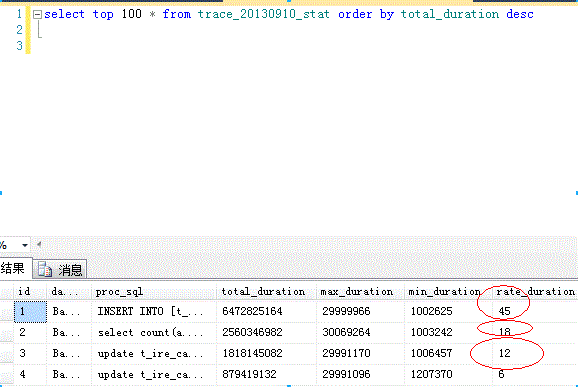
2)查询某个过程或者sql语句详情
select * from [trace_20130910] where proc_sql_id = 1

这是根据duration排序,稍微改下就可以按reads排序,因为步骤毕竟多,而且经常会用到,所以整理成一个存储过程。方便以后分析性能问题。
找了半天发现不能上传附件。





【推荐】国内首个AI IDE,深度理解中文开发场景,立即下载体验Trae
【推荐】编程新体验,更懂你的AI,立即体验豆包MarsCode编程助手
【推荐】抖音旗下AI助手豆包,你的智能百科全书,全免费不限次数
【推荐】轻量又高性能的 SSH 工具 IShell:AI 加持,快人一步
· 如何编写易于单元测试的代码
· 10年+ .NET Coder 心语,封装的思维:从隐藏、稳定开始理解其本质意义
· .NET Core 中如何实现缓存的预热?
· 从 HTTP 原因短语缺失研究 HTTP/2 和 HTTP/3 的设计差异
· AI与.NET技术实操系列:向量存储与相似性搜索在 .NET 中的实现
· 周边上新:园子的第一款马克杯温暖上架
· Open-Sora 2.0 重磅开源!
· .NET周刊【3月第1期 2025-03-02】
· 分享 3 个 .NET 开源的文件压缩处理库,助力快速实现文件压缩解压功能!
· [AI/GPT/综述] AI Agent的设计模式综述